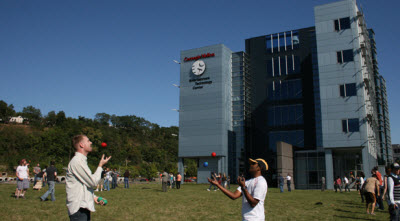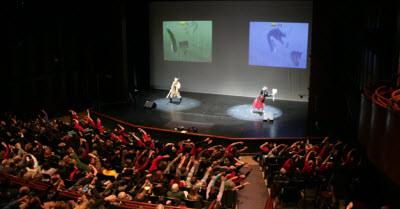Disclosure: The organizers of Siggraph paid part of my expenses to Anaheim, Calif. Our coverage remains objective.
One of early giants in computer-generated animation is helping a new generation of would-be digital entertainers learn about starting their own businesses.
Carl Rosendahl is a pioneer in CG filmmaking as the founder and president of Pacific Data Images, the animation company that created the film Antz in 1998. He sold 40 percent of the film to DreamWorks in 1995 and then sold the rest of it in 2000. The company is still making lots of animated films, giving Disney’s Pixar studio some serious competition in the renaissance of computer-generated movies. Rosendahl moved on to become a venture capitalist at Mobius Venture Capital, but he didn’t like that so much during the depth of the dotcom crash.
Now he is an associate professor at the Entertainment Technology Center at Carnegie Mellon University, where he teaches, among other things, game entrepreneurship. In the program, he takes students through the process of creating a new game company and getting them to work on their first product. As he knows from experience, it isn’t an easy task.
We interview Rosendahl at the Siggraph Business Symposium in Anaheim, Calif., this week. Here’s an edited transcript of our interview.
GamesBeat: Tell me about the university program.
Carl Rosendahl: It’s the Entertainment Technology Center at Carnegie Mellon. It’s a two-year master’s program between the drama department and the computer science department. They originally came together 15 or 20 years ago to create the program. It’s very much a project-based curriculum. The first semester, there’s a lot of core classes that everyone takes. After that, each semester the students work in teams of four to eight on a single project.
As faculty members, we teach some elective classes, but a lot of what we do is mentor and advise them through the process of creating these projects. Some of them are done in conjunction with outside companies. We do things with Microsoft, Electronic Arts, Lockheed, all sorts of corporations. Some of the projects are student-pitched and some are faculty-pitched.
GamesBeat: How much of the focus is on running a game project or running a game studio versus running other kinds of businesses?
Rosendahl: Most of the projects are interactive-based. There are a few linear projects. But they’re all over the map. A lot of them are game-oriented, but some of them are location-based installations. That can be entertainment, but it can also be activities for — there’s a great project with the Children’s Museum in Pittsburgh that’s essentially doing maker technology. Kids can go in and learn how to design and build things.
GamesBeat: Do you run into a lot of common mistakes that people make when they’re starting off in things like this, either starting a game or starting a studio?
Rosendahl: Sure. I do an elective class on entrepreneurship. I try to expose them to the whole first-year life cycle of what you go through in the context of doing entertainment technology of some sort. I have the students create a fictitious company in teams of two and walk them through the whole process. Most of the projects, though, the core curriculum the students work on, are real projects where the build, at a minimum, a functioning prototype by the end of the semester.
They run into all sorts of challenges. At the beginning, sometimes the definitions of these projects are pretty broad. It’s a few paragraphs explaining what they’re going to do. Sometimes it’s much more well defined. They spend the first three weeks or so doing conceptual design, and then after that they spend the rest of the semester building the prototype and doing a very iterative process. Get something to work. Do a lot of user testing. Get feedback from that. Iterate through that. A lot of times they refine the project based on real user feedback.
GamesBeat: It sounds like hands-on is the best way to teach people this.
Rosendahl: Absolutely. They run into all sorts of challenges. They run into scoping issues all the time. Every semester, on every project, their vision of what they’re going to accomplish in 16 weeks is almost always much greater than what they can accomplish in 16 weeks. Sometimes it’s technology. Sometimes it’s with a client. Sometimes it’s your users. It turns out that your idea wasn’t so great after all, or people aren’t adapting to it the way you wanted them to.
Then you have great opportunities for learning about being on a team. [Laughs] All the issues with how you cooperate together, how you maximize everyone’s contribution, and sometimes how you deal with all the conflicts that come up. I say “sometimes.” It should be “usually.” Conflicts arise in the teams. We help work with them and teach them how to figure out the best path through those situations.
GamesBeat: There’s this vocational aspect to it. If you look at it from three miles up, what do you see in the games industry itself? What do you think is changing? There seem to be some good things happening, like Kickstarter. That’s helping a lot of games get off the ground now. There are also a lot of things in the way of trying to start something smaller.
Rosendahl: On the one hand, it’s an amazing time to be a game developer or any other kind of interactive project developer. So many off-the-shelf tools are available. They’re incredibly powerful and cheap, if not free. You can get up and running very fast and develop a prototype for people to start playing with almost instantly. That’s very exciting.
The challenge is that everyone else has access to all that, too. [Laughs] The barriers to entry are essentially zero now, so you need incredible creative abilities to imagine something unique that no one else is doing. You need the ability to deliver visually stunning work, because the audience expectation is so high. If you’re in a position where you can push yourself forward by doing unique R&D and not just relying on off-the-shelf tools – if you can develop tools, techniques, pipelines, whatever that give you the ability to produce stuff that isn’t available that way, or do it more efficiently or effectively somehow – these guys will have some very interesting things to say about how they get a competitive edge out of doing that.
It’s an interesting balance. On the one hand, there’s incredible opportunity, because if you have an idea you can start implementing it right away. Then there’s the challenge of how you differentiate yourself against everyone else.
GamesBeat: With Pacific Data Images, is there a comparison you would make there to how you guys got off the ground?
Rosendahl: I started PDI in 1980. There was no off-the-shelf software. A computer animation system was called a “C compiler.” [laughs] It’d do anything if you could tell it what to do. It was a very large challenge to develop a computer animation system from scratch and make it do what you wanted it to do. In fact, it took us a few years to be able to do broadcast graphics and then leverage off of that. We had a long-term vision of getting to the point where we could make a fully animated feature film. It took us about 15 years to get there. It wasn’t possible when we started, but technology and the skill sets of the people we brought in all converged on that vision. Today it’s a different world.
GamesBeat: There is no R&D anymore, right?
Rosendahl: There is, but it’s very different. It’s on the edges, trying to figure out what R&D you can do to gain an edge over everyone else. As opposed to a green field, where you can go in and just create stuff because very few other people are doing the same. In fact, if you look back at the ’80s, everyone who was trying to do that—technically, we were competitors, but more realistically we were co-conspirators. We all wanted the industry to succeed.
Even when you lost a job to one of your competitors, you wanted them to do really well, because that would create demand. The clients would say, “We had a great experience. We got a wonderful product. We want to keep doing that.” If they blew it, people would say, “Eh, computer animation, that’s hard to do, it’s expensive, it sucks.” The competitive landscape is very different now.
GamesBeat: Is there a direction that you’d encourage people to go in or look at if they don’t have an idea of exactly what they want to do yet?
Rosendahl: All the augmented reality stuff is a huge opportunity. We’re only beginning to imagine what can be done with that, and only beginning to get the hardware that’s going to implement it. Google Glass is very cool — but it’s the first generation. Jump out 15 years and that’s going to be pretty amazing stuff, when you get to the fourth or fifth generation. We’ll just laugh at all the versions today. “They were big, they were clunky, low resolution, slow, cumbersome.” All those issues are going to go away.
To me, the big open opportunity is, “What do you build for that?” Don’t look at what you build for Oculus Rift or Google Glass today. Look at what you’re going to want to build when that technology is four generations older. Then figure out what tools you want to start putting into place today, what skill sets you want to start developing today, that are going to be valuable down the road when that technology is starting to mature.




